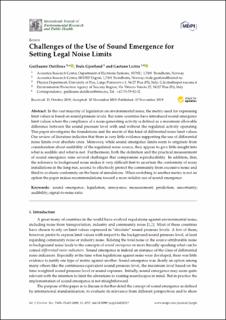| dc.contributor.author | Dutilleux, Guillaume | |
| dc.contributor.author | Gjestland, Truls Tormodsønn | |
| dc.contributor.author | Licitra, Gaetano | |
| dc.date.accessioned | 2020-06-18T11:27:16Z | |
| dc.date.available | 2020-06-18T11:27:16Z | |
| dc.date.created | 2019-11-16T15:18:44Z | |
| dc.date.issued | 2019 | |
| dc.identifier.citation | International Journal of Environmental Research and Public Health. 2019, 16 4517-?. | en_US |
| dc.identifier.issn | 1660-4601 | |
| dc.identifier.uri | https://hdl.handle.net/11250/2658636 | |
| dc.description.abstract | In the vast majority of legislation on environmental noise, the metric used for expressing limit values is based on sound pressure levels. But some countries have introduced sound emergence limit values where the compliance of a noise-generating activity is defined as a maximum allowable difference between the sound pressure level with and without the regulated activity operating. This paper investigates the foundations and the merits of this kind of differential noise limit values. Our review of literature indicates that there is very little evidence supporting the use of differential noise limits over absolute ones. Moreover, while sound emergence limits seem to originate from consideration about audibility of the regulated noise source, they appear to give little insight into what is audible and what is not. Furthermore, both the definition and the practical measurement of sound emergence raise several challenges that compromise reproducibility. In addition, first, the reference to background noise makes it very difficult first to ascertain the conformity of noisy installations in the long run, second to effectively protect the community from excessive noise and third to evaluate conformity on the basis of simulations. When switching to another metric is not an option the paper makes recommendations toward a more reliable use of sound emergence. | en_US |
| dc.language.iso | eng | en_US |
| dc.publisher | MDPI | en_US |
| dc.rights | Navngivelse 4.0 Internasjonal | * |
| dc.rights.uri | http://creativecommons.org/licenses/by/4.0/deed.no | * |
| dc.subject | Sound emergence | en_US |
| dc.subject | Legislation | en_US |
| dc.subject | Annoyance | en_US |
| dc.subject | Measurement | en_US |
| dc.subject | Prediction | en_US |
| dc.subject | Uncertainty | en_US |
| dc.subject | Audibility | en_US |
| dc.subject | Signal-to-noise ratio | en_US |
| dc.title | Challenges of the Use of Sound Emergence for Setting Legal Noise Limits | en_US |
| dc.type | Journal article | en_US |
| dc.type | Peer reviewed | en_US |
| dc.description.version | publishedVersion | en_US |
| dc.rights.holder | This is an open access article distributed under the Creative Commons Attribution License which permits unrestricted use, distribution, and reproduction in any medium, provided the original work is properly cited | en_US |
| dc.source.pagenumber | 1-14 | en_US |
| dc.source.volume | 16 | en_US |
| dc.source.journal | International Journal of Environmental Research and Public Health | en_US |
| dc.source.issue | 22 | en_US |
| dc.identifier.doi | 10.3390/ijerph16224517 | |
| dc.identifier.cristin | 1748304 | |
| cristin.unitcode | 7401,90,22,0 | |
| cristin.unitname | Connectivity Technologies and Platforms | |
| cristin.ispublished | true | |
| cristin.fulltext | original | |
| cristin.qualitycode | 1 | |

